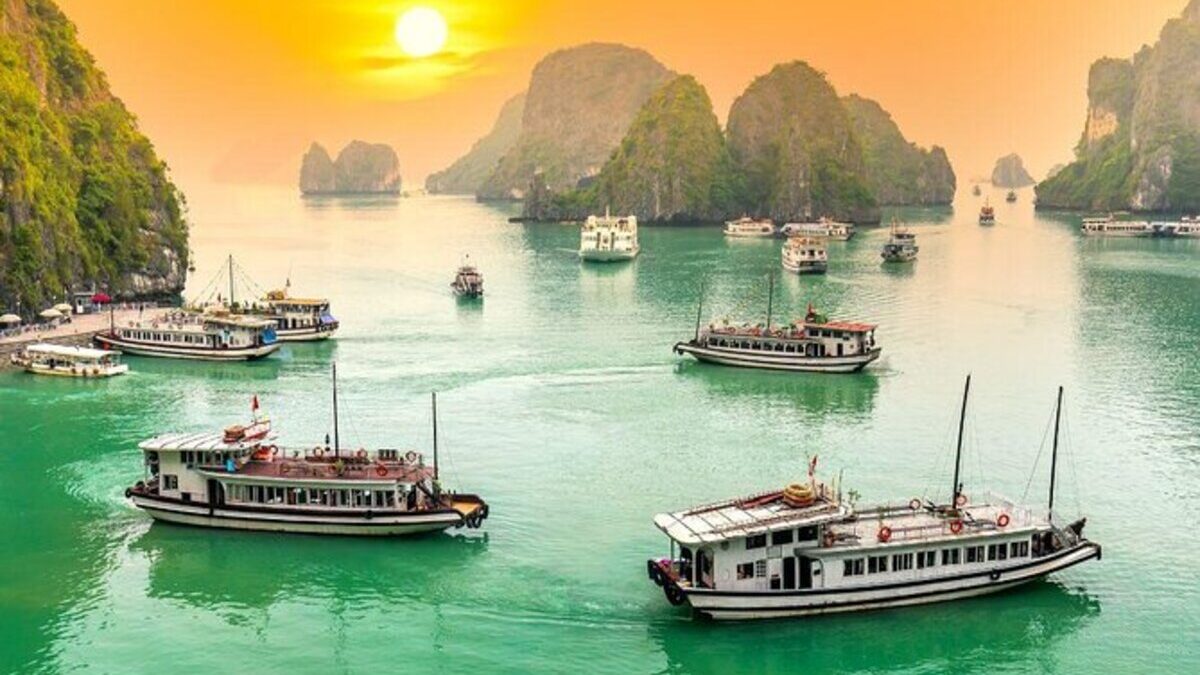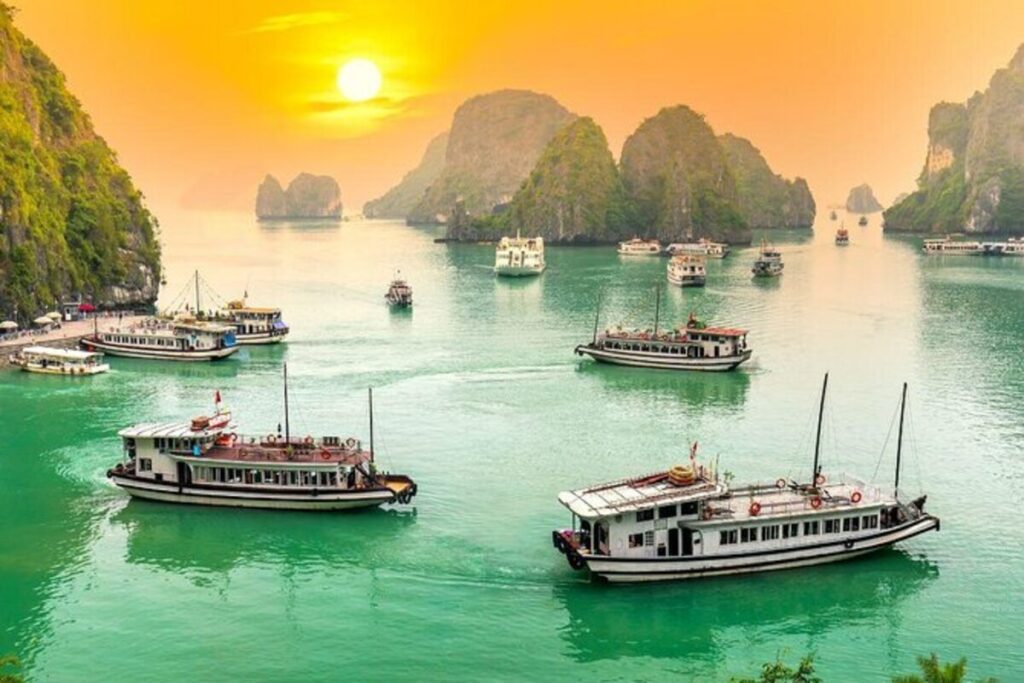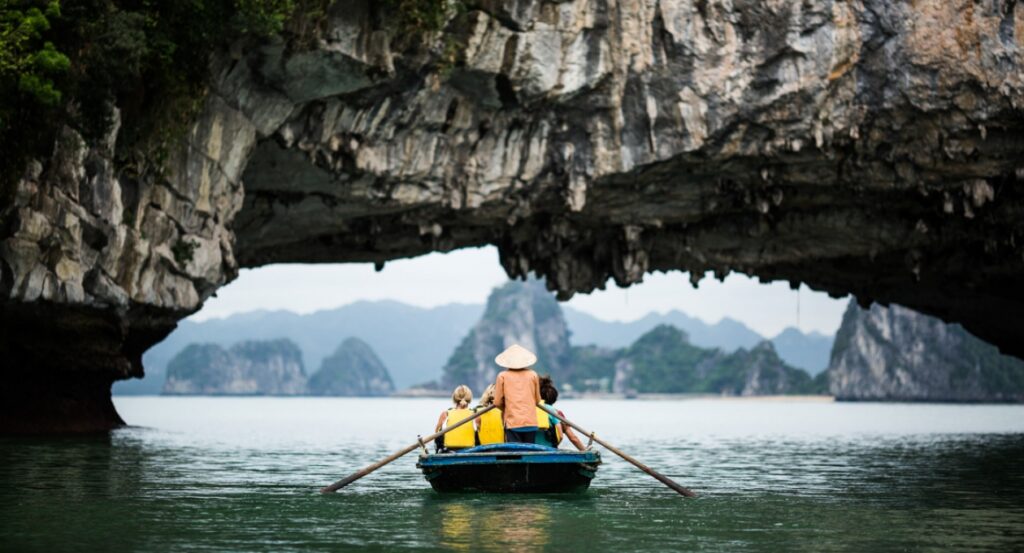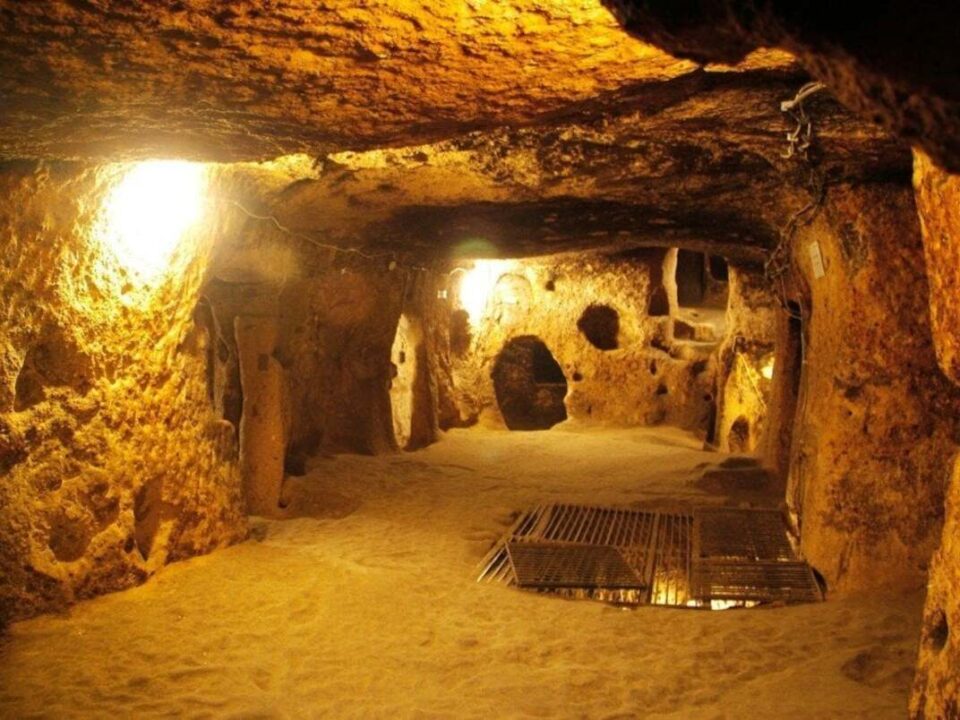Ha Long Bay Vietnam A Natural Wonder of the World

Ha Long Bay, Vietnam: A Natural Wonder of the World
Welcome to Ha Long Bay, one of Vietnam’s most breathtaking natural treasures and a UNESCO World Heritage Site. Located in the Gulf of Tonkin, this stunning bay is renowned for its emerald waters, towering limestone karsts, and mystical caves. Ha Long Bay, which means “Descending Dragon” in Vietnamese, is a must-visit destination for travelers seeking to experience the natural beauty and cultural richness of Vietnam. This comprehensive guide provides everything you need to know for an unforgettable visit to Ha Long Bay, including its history, key attractions, unique features, and practical information for tourists.

A Glimpse into the History of Ha Long Bay
Geological Formation
Ha Long Bay’s unique landscape is the result of millions of years of geological processes.
- Karst Topography: The bay’s distinctive karst landscape, characterized by thousands of limestone pillars and islets, was formed over 500 million years ago. The region has undergone several periods of tectonic uplift and erosion, creating the dramatic cliffs, caves, and grottoes that define the bay today.
- Erosion and Weathering: Over time, the action of water, wind, and temperature fluctuations has sculpted the limestone into the stunning shapes seen today. The bay’s karst formations are considered among the best examples of their kind in the world.
Cultural Significance
Ha Long Bay has been inhabited by humans for thousands of years and holds significant cultural and historical value.
- Ancient Inhabitants: Archaeological evidence suggests that prehistoric cultures lived in the region as early as 18,000 years ago. These ancient peoples relied on the bay’s abundant marine resources and left behind artifacts, including pottery and tools, which provide insights into their way of life.
- Legends and Myths: According to Vietnamese legend, the bay was created by a dragon sent by the gods to protect Vietnam from invaders. The dragon descended from the heavens and spat out jade and jewels, which turned into the islands and islets that dot the bay. This mythical origin is reflected in the name “Ha Long,” which means “Descending Dragon.”
UNESCO World Heritage Site
In 1994, Ha Long Bay was designated a UNESCO World Heritage Site, recognizing its outstanding natural beauty and geological significance.
- Global Recognition: The UNESCO designation has helped to protect and preserve Ha Long Bay, ensuring that its unique landscapes and ecosystems are safeguarded for future generations. The bay has since become one of Vietnam’s most popular tourist destinations.
Key Attractions of Ha Long Bay
The Limestone Karsts and Islets
Ha Long Bay is home to nearly 2,000 limestone karsts and islets, each with its own unique shape and character.
- Dau Go Island: One of the largest and most famous islands in Ha Long Bay, Dau Go Island is known for its beautiful caves and rich vegetation. The island’s name means “Wooden Stakes,” referring to a legend in which wooden stakes were hidden in the cave to trap invading Mongol ships.
- Ga Choi Islet (Fighting Cock Islet): Ga Choi Islet is one of the most iconic images of Ha Long Bay. The islet consists of two towering rocks that resemble a pair of fighting cocks. It is a popular spot for photography and is often featured in postcards and travel brochures.
- Hon Dinh Huong (Incense Burner Islet): Another famous formation, Hon Dinh Huong, resembles an incense burner used in traditional Vietnamese temples. This solitary islet is a symbol of the spiritual connection between the bay and its people.
The Caves and Grottos
Ha Long Bay is renowned for its numerous caves and grottoes, which are natural wonders in their own right.
- Sung Sot Cave (Surprise Cave): Sung Sot Cave is one of the largest and most impressive caves in Ha Long Bay. The cave is divided into two main chambers, each filled with stunning stalactites and stalagmites. The interior is illuminated by colorful lights, highlighting the intricate rock formations.
- Thien Cung Cave (Heavenly Palace Cave): Thien Cung Cave is known for its magnificent stalactites and stalagmites, which create the appearance of a palace fit for the gods. The cave is filled with natural sculptures that resemble mythical creatures, such as dragons and phoenixes, making it a popular spot for exploration.
- Dau Go Cave (Wooden Stakes Cave): Dau Go Cave is another significant cave in Ha Long Bay, with historical connections to Vietnam’s fight against Mongol invaders in the 13th century. The cave is named after the wooden stakes that were used in battle and later hidden inside the cave. It features three main chambers with impressive rock formations and panoramic views of the bay.

The Floating Villages
The floating villages of Ha Long Bay offer a glimpse into the traditional way of life of the local fishing communities.
- Vung Vieng Village: Vung Vieng is one of the largest and most visited floating villages in Ha Long Bay. The village is home to a small community of fishermen and their families, who live in floating houses and rely on fishing as their primary source of livelihood. Visitors can take a boat tour of the village, interact with the locals, and learn about their unique way of life.
- Cua Van Village: Cua Van is another well-known floating village in Ha Long Bay, famous for its picturesque setting and traditional culture. The village is surrounded by towering limestone cliffs, creating a serene and peaceful atmosphere. Visitors can explore the village by kayak or bamboo boat and visit the local museum to learn more about the history and culture of the area.
Unique Features of Ha Long Bay
Biodiversity and Ecosystems
Ha Long Bay is a biodiversity hotspot, home to a wide range of plant and animal species.
- Marine Life: The bay’s waters are rich in marine life, including over 200 species of fish, 450 species of mollusks, and numerous species of crustaceans. The coral reefs in the bay are home to vibrant marine ecosystems, making Ha Long Bay a popular destination for snorkeling and diving.
- Endangered Species: Ha Long Bay is home to several endangered species, including the white-headed langur, one of the rarest primates in the world. The bay’s unique limestone karsts provide a habitat for these and other species, highlighting the importance of conservation efforts in the region.
- Flora and Fauna: The islands and islets of Ha Long Bay are covered in lush vegetation, including mangroves, tropical forests, and coastal shrubs. The diverse plant life supports a variety of bird species, reptiles, and insects, contributing to the overall biodiversity of the area.
Cultural and Historical Sites
In addition to its natural beauty, Ha Long Bay is home to several cultural and historical sites.
- Bai Tho Mountain (Poem Mountain): Bai Tho Mountain is a limestone hill located near Ha Long City, offering panoramic views of the bay. The mountain is named after a famous poem inscribed on its cliffs by King Le Thanh Tong in the 15th century. The poem praises the beauty of Ha Long Bay and reflects the cultural significance of the landscape.
- Yen Tu Mountain: Located near Ha Long Bay, Yen Tu Mountain is an important pilgrimage site for Vietnamese Buddhists. The mountain is home to several ancient pagodas and temples, including the Dong Pagoda, which sits at the mountain’s summit. The pilgrimage to Yen Tu is a spiritual journey that offers both physical challenge and profound tranquility.
- Quan Lan Island: Quan Lan Island is one of the few inhabited islands in Ha Long Bay, with a rich history dating back to the 11th century. The island was an important trading post during the Ly Dynasty and is home to several historical sites, including the Quan Lan Pagoda and the ancient Van Don Port.
Practical Information for Visitors
Getting There
Ha Long Bay is located in Quang Ninh Province, about 170 kilometers (105 miles) east of Hanoi, Vietnam’s capital.
- By Air: The nearest airport to Ha Long Bay is Van Don International Airport (VDO), located about 50 kilometers from the bay. The airport offers flights from major cities in Vietnam and some international destinations. From the airport, visitors can take a taxi or shuttle bus to Ha Long Bay.
- By Road: Ha Long Bay is easily accessible by road from Hanoi. The journey takes about 3 to 4 hours by car or bus. Several bus companies operate regular services between Hanoi and Ha Long City, with comfortable and affordable options available.
- By Train: There is a train service from Hanoi to Ha Long City, although it is less popular than other modes of transportation due to longer travel times. The train journey offers scenic views of the countryside and is a good option for those who prefer a leisurely pace.
Best Times to Visit
The best time to visit Ha Long Bay is during the spring (March to May) and autumn (September to November) when the weather is mild and the skies are clear.
- Spring: Spring is one of the most popular times to visit Ha Long Bay, with pleasant temperatures and blooming flowers adding to the beauty of the landscape. The bay is less crowded during this time, making it an ideal season for exploration.
- Autumn: Autumn is another great time to visit Ha Long Bay, with cooler temperatures and fewer tourists. The bay’s waters are calm, and the visibility is excellent, making it a perfect time for activities like kayaking, swimming, and cruising.
- Avoiding the Monsoon Season: The monsoon season in Ha Long Bay runs from June to August, bringing heavy rains and occasional storms. While the bay remains beautiful during this time, it is advisable to check weather conditions before planning your visit.
Accommodation and Cruises
Ha Long Bay offers a wide range of accommodation options, from budget hostels to luxury resorts and
cruises.
- Cruises: One of the best ways to experience Ha Long Bay is by taking a cruise. Cruises range from day trips to multi-day journeys, with options for every budget. Luxury cruises offer amenities like private cabins, gourmet dining, and guided excursions to the bay’s attractions, while budget cruises provide a more affordable way to explore the bay.
- Hotels and Resorts: For those who prefer to stay on land, there are several hotels and resorts in Ha Long City and the surrounding areas. Many of these accommodations offer stunning views of the bay and easy access to the main attractions.
- Homestays: For a more authentic experience, consider staying in a homestay in one of the floating villages or on an island in the bay. Homestays offer the opportunity to live with local families and learn about their traditional way of life.
Tips for an Enjoyable Visit
Choosing the Right Cruise
Selecting the right cruise is key to having a memorable experience in Ha Long Bay.
- Duration: Consider how much time you want to spend in the bay. Day cruises offer a quick overview of the main attractions, while overnight and multi-day cruises allow for a more in-depth exploration of the bay.
- Itinerary: Check the cruise itinerary to ensure it includes the attractions you’re most interested in, such as specific caves, islands, and floating villages.
- Facilities: Consider the facilities and services offered on the cruise, including cabin size, dining options, activities, and guides. Luxury cruises typically offer more amenities, but there are also many mid-range options that provide a comfortable experience at a reasonable price.
Responsible Tourism
Ha Long Bay is a fragile ecosystem, and it’s important to practice responsible tourism during your visit.
- Respect the Environment: Avoid littering and be mindful of your impact on the environment. Stick to designated paths, and refrain from touching or removing marine life, corals, or plants.
- Support Local Communities: Choose locally-owned businesses and services, such as homestays, restaurants, and tour operators, to support the livelihoods of people who depend on tourism. Engaging with the local community can also enrich your experience.
- Eco-Friendly Practices: Opt for eco-friendly tour operators who prioritize sustainability and environmental conservation. Some cruises and tours are committed to minimizing their environmental footprint through practices like waste reduction, responsible waste disposal, and supporting conservation efforts.
Must-See Highlights at Ha Long Bay
The Limestone Karsts and Islets
Exploring the bay’s limestone karsts and islets is a highlight of any visit to Ha Long Bay.
- Dau Go Island: Known for its impressive caves and rich vegetation, Dau Go Island is a must-see destination. The island offers beautiful landscapes and a sense of serenity away from the busier parts of the bay.
- Ga Choi Islet: One of the most iconic images of Ha Long Bay, Ga Choi Islet resembles a pair of fighting cocks and is a popular spot for photography.
- Hon Dinh Huong: This solitary islet, resembling an incense burner, is a symbol of the spiritual connection between the bay and its people.
The Caves and Grottos
Ha Long Bay’s caves and grottos are natural wonders that offer a glimpse into the bay’s geological history.
- Sung Sot Cave: The largest and most famous cave in Ha Long Bay, Sung Sot Cave features two main chambers filled with stunning stalactites and stalagmites. The cave’s interior is illuminated by colorful lights, enhancing its beauty and creating a mystical atmosphere.
- Thien Cung Cave: Known for its magnificent rock formations, Thien Cung Cave is often referred to as the “Heavenly Palace.” The cave is filled with natural sculptures that resemble mythical creatures, making it a popular spot for exploration.
The Floating Villages
The floating villages of Ha Long Bay offer a unique insight into the traditional way of life of the local fishing communities.
- Vung Vieng Village: One of the largest floating villages in the bay, Vung Vieng is home to a small community of fishermen and their families. Visitors can take a boat tour of the village, interact with the locals, and learn about their unique way of life.
- Cua Van Village: Surrounded by towering limestone cliffs, Cua Van Village is one of the most picturesque floating villages in Ha Long Bay. Visitors can explore the village by kayak or bamboo boat and visit the local museum to learn more about the history and culture of the area.

Conclusion
Ha Long Bay, with its stunning landscapes, rich biodiversity, and vibrant culture, offers an unforgettable experience for all who visit. From exploring the bay’s towering limestone karsts and mystical caves to discovering the unique way of life in the floating villages, Ha Long Bay provides a journey into one of the world’s most beautiful and serene natural wonders. Plan your trip to Ha Long Bay and immerse yourself in the beauty, history, and mystique of this remarkable destination, where nature and culture come together in perfect harmony. Embrace the opportunity to explore, discover, and create lasting memories in this magnificent jewel of Vietnam.
-
Ha Long Bay Vietnam A Natural Wonder of the World
Ha Long Bay, Vietnam: A Natural Wonder of the World Welcome to Ha Long Bay, one of Vietnam’s most breathtaking natural treasures and a UNESCO World […]



1 Comment
Muchas gracias. ?Como puedo iniciar sesion?